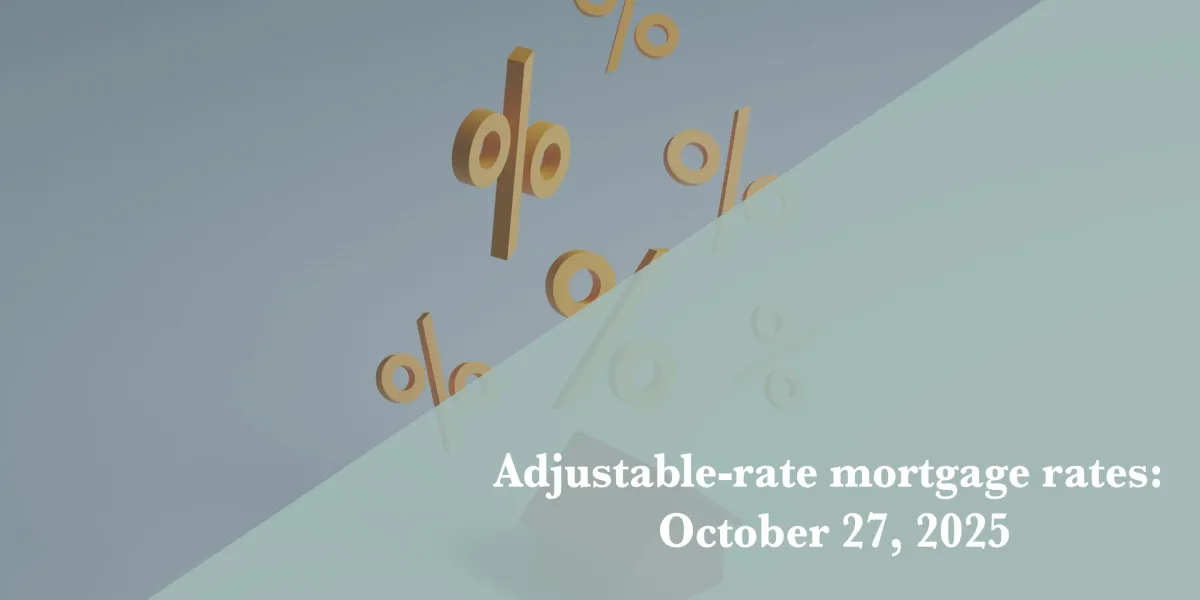Copyright Fortune

Read on and we’ll explain how an ARM works, when you might want to consider an ARM over a fixed-rate loan, and look at current ARM rates from a few top lenders. You can see the previous business day’s ARM rates report here. Average ARM mortgage rates Fortune reviewed the most recent data available as of October 24, 2025. These are sample rates provided by the institutions. Each one is based off specific assumptions about a hypothetical borrower’s credit profile and location. Estimates may include an assumption of mortgage discount points. If you choose to apply, know that the rate you receive may vary from the sample rates shown here. A 7/6 ARM is one with a fixed rate for seven years, then adjustment periods every six months. Fixed-rate vs. adjustable-rate mortgages About 92% of households with mortgages have fixed-rate home loans. Unlike ARMs, where the interest rate can fluctuate after an initial fixed-rate period, your rate is the same for the life of the loan when you have a fixed-rate mortgage. It’s easy to see why that’s a popular option. However, ARMs can make sense in certain situations. In other words, you might find you’re among the roughly 8% of mortgage holders who decide this type of loan offers an opportunity. When you might consider an adjustable-rate mortgage Here are three categories of homebuyer for whom ARMs can be helpful: Buyers of temporary or “starter homes.” If you’re fairly confident you won’t be in your home for long, an ARM might be a strategic choice since you can take advantage of the low fixed-period interest rate and then sell the home before the adjustment period hits. Investors. Many real estate investors like ARMs for a similar reason. They may secure a low interest rate upfront, and as the adjustment period approaches in three, five, or seven years, can adjust the rent to reflect the new mortgage payment or flip the property and buy the next one. Buyers during periods of high interest rates. Finally, many buyers go out on a limb with an adjustable-rate mortgage during periods of high interest since it’s more likely to offer a lower rate upfront and on the back end, assuming things cool off by the time your fixed period expires. How adjustable-rate mortgages work ARMs typically start off with a low, fixed interest rate for a set period of time—such as three, five, seven or 10 years—and after the “fixed period” expires, the “adjustment period” begins. Here’s where things get interesting. During the adjustment period, the interest rate on your ARM can fluctuate based on several key factors, including: Benchmark rates. ARMs commonly get their base interest rate from a benchmark called the Secured Overnight Financing Rate (SOFR). The U.S. Treasury publishes a new SOFR each morning as a way to tell banks and lenders “hey, here’s the cost of borrowing cash today.” That, in turn, helps lenders set market-appropriate interest rates for various products from auto loans to mortgages. Margins. The margin is a fixed percentage that your lender adds to the index to come up with your ARM interest rate. So if you have an ARM tied to the SOFR and the SOFR is 5% while your margin is 2%, your ARM rate will be 7%. Margins typically range between 2% and 3.5% and can vary based on the lender, loan and your creditworthiness. Margins are also set in stone as part of the loan agreement, so it’s best to shop around to see which lenders can offer more competitive margins. Rate caps. Finally, rate caps put a limit on how much your rate can rise throughout the course of the loan. “Initial” adjustment caps control how much the rate can rise the first time, “subsequent” adjustment caps dictate how it can rise after the initial cap, and “lifetime” adjustment caps put a limit on how much your interest rate can increase in total. The most common ARM length may be the 5/1, meaning the loan has a fixed interest rate for five years, and once that expires, the interest rate will start changing every one year for 25 years (most ARMs have 30-year terms). Another common ARM length is the 10/6, meaning you’ll have a 10-year fixed period and a 20-year adjustment period during which the interest rate will change every six months. You may also see 3/1 ARMs, 7/1 ARMs and 10/1 ARMs. Learn more: Why the Secured Overnight Financing Rate might matter for your mortgage. Refinancing from an ARM to a fixed-rate mortgage Sometimes, even if it was advantageous to buy your property using an ARM, you eventually realize a fixed-rate mortgage would be preferable looking ahead. For instance, maybe you’ve decided your first home is going to be a long-term home after all. You’re not alone if that’s the situation—research from 2024 found that a substantial number of Millennial and Gen Z homeowners can’t afford to upgrade and are making do with their starter homes. Regardless of the specific reason, know that it is possible to refi from an ARM to a fixed-rate mortgage. In fact, it’s probably a fairly common reason for ARM holders to refinance. Refinancing from an ARM to a fixed-rate mortgage isn’t rocket science, and works pretty much like refinancing from fixed-to-fixed. You’ll apply with multiple lenders to find the best rates, provide the necessary documentation, close on your new loan and pay your old loan in full. Pros and cons of adjustable-rate mortgages Like any other mortgage type, ARMs come with a mix of pros and cons. While your lender can ultimately decide which mortgage type is right for you, knowing the basics can help you budget and navigate the early steps of the process:



